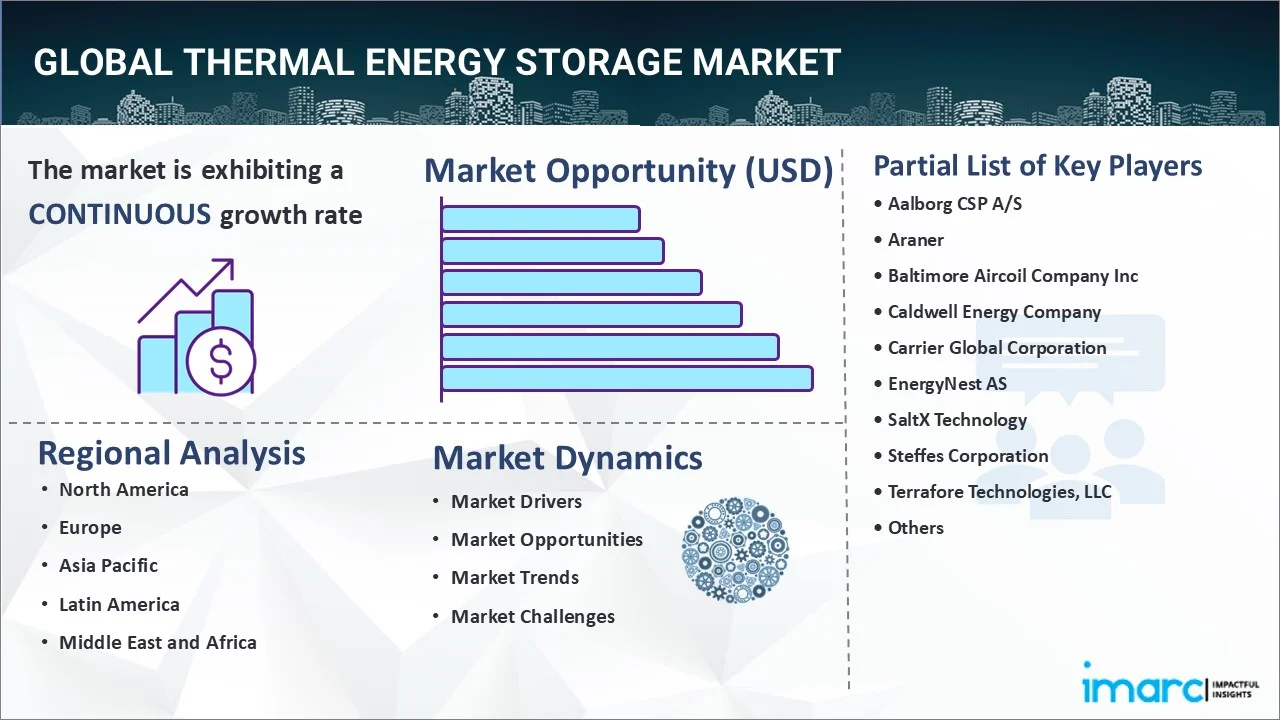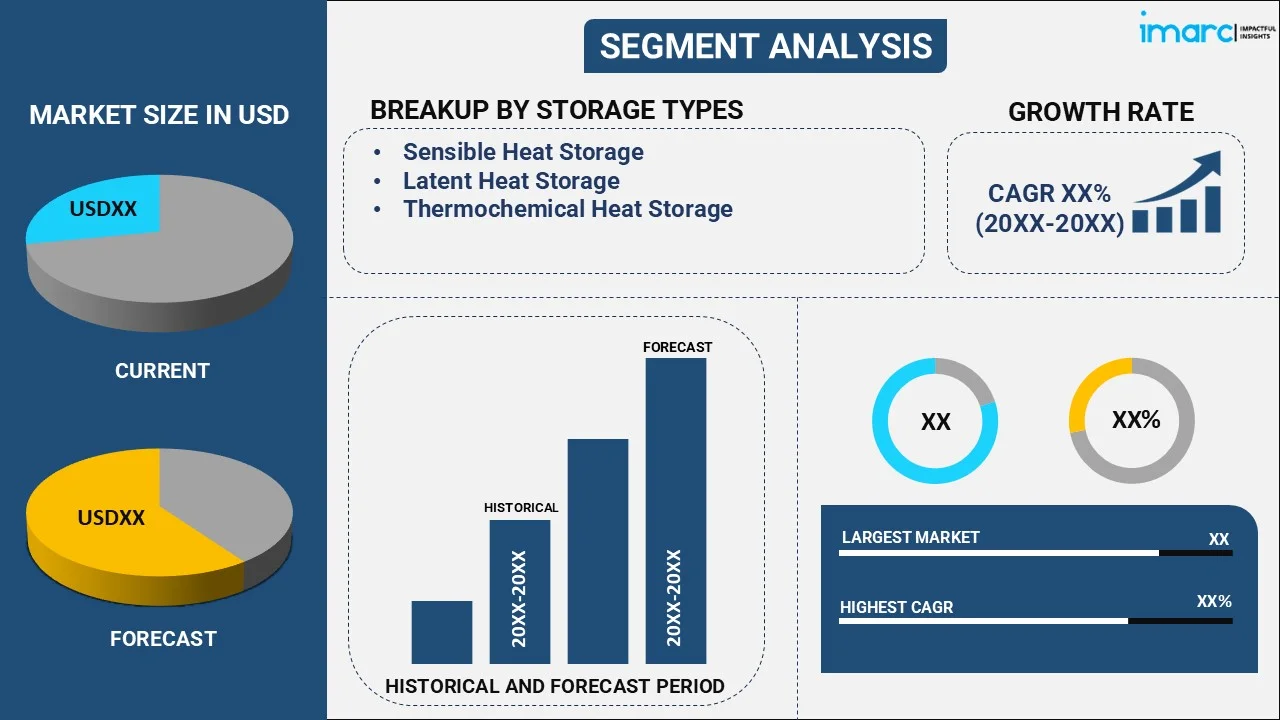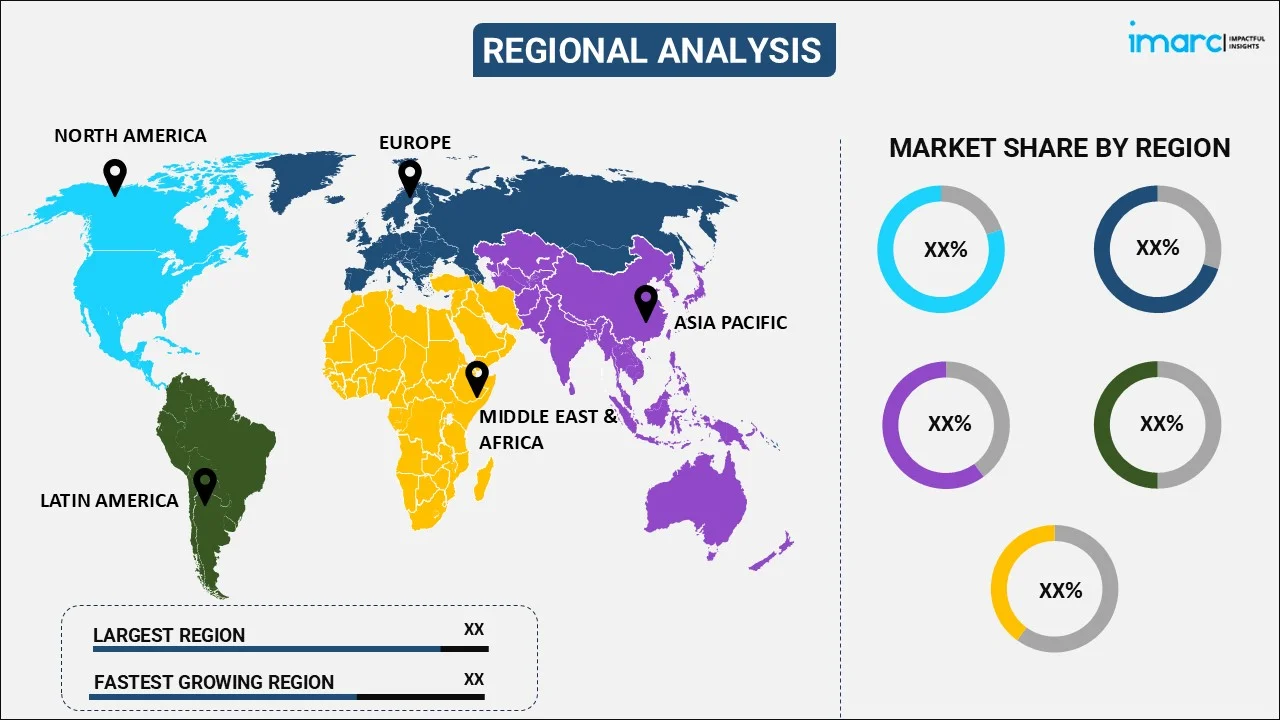
Thermal Energy Storage Market Report by Storage Type (Sensible Heat Storage, Latent Heat Storage, Thermochemical Heat Storage), Technology (Molten Salt Technology, Electric Thermal Storage Heaters, Solar Energy Storage, Ice-Based Technology, Miscibility Gap Alloy Technology (MGA), and Others), Material Type (Water, Molten Salt, Phase Change Materials (PCM), and Others), Application (Power Generation, District Heating and Cooling, Process Heating and Cooling), End-Use (Residential and Commercial Sector, Utility Industry, and Other Industries), and Region 2025-2033
Market Overview:
The global thermal energy storage market size reached USD 7.5 Billion in 2024. Looking forward, IMARC Group expects the market to reach USD 15.5 Billion by 2033, exhibiting a growth rate (CAGR) of 8.4% during 2025-2033.
|
Report Attribute
|
Key Statistics
|
|---|---|
|
Base Year
|
2024
|
|
Forecast Years
|
2025-2033
|
|
Historical Years
|
2019-2024
|
| Market Size in 2024 | USD 7.5 Billion |
| Market Forecast in 2033 | USD 15.5 Billion |
| Market Growth Rate 2025-2033 | 8.4% |
Thermal energy storage refers to a power storage system that is used for transferring and storing energy obtained from ice, cold air or water for later usage. It includes sensible, latent and thermochemical heat storage that is based on molten salt, ice and miscibility gap alloy technology (MGA). Some of these solutions are used for storing hot or cold energy for powering electrical systems in commercial and residential complexes, while others are used for storing solar energy in the summers, which is further utilized in the winters. This aids in preventing the overutilization of conventional energy from the grid systems.

To get more information on this market, Request Sample
Increasing emphasis on the utilization of renewable energy resources across the globe is one of the key factors driving the growth of the market. The growing demand for thermal energy storage systems in heating, ventilation and air conditioning (HVAC) technology for large-scale heating and cooling is also providing a boost to the market growth. Furthermore, concentrated solar power (CSP) is increasingly being integrated with the thermal energy storage systems to offer grid flexibility and minimize efficiency losses by generating electricity through dry cooling during lower ambient temperatures. Additionally, increasing environmental consciousness, coupled with the growing adoption of thermal energy storage for power generation in green buildings, is acting as another growth-inducing factor. Other factors, including the implementation of favorable government policies to promote sustainable infrastructural development, along with extensive research and development (R&D) activities, are projected to drive the market further.
Key Market Segmentation:
IMARC Group provides an analysis of the key trends in each sub-segment of the global thermal energy storage market report, along with forecasts at the global, regional and country level from 2025-2033. Our report has categorized the market based on storage type, technology, material type, application and end-use.
Breakup by Storage Type:

- Sensible Heat Storage
- Latent Heat Storage
- Thermochemical Heat Storage
Breakup by Technology:
- Molten Salt Technology
- Electric Thermal Storage Heaters
- Solar Energy Storage
- Ice-Based Technology
- Miscibility Gap Alloy Technology (MGA)
- Others
Breakup by Material Type:
- Water
- Molten Salt
- Phase Change Materials (PCM)
- Others
Breakup by Application:
- Power Generation
- District Heating and Cooling
- Process Heating and Cooling
Breakup by End-Use:
- Residential and Commercial Sector
- Utility Industry
- Other Industries
Breakup by Region:

- North America
- United States
- Canada
- Asia Pacific
- China
- Japan
- India
- South Korea
- Australia
- Indonesia
- Others
- Europe
- Germany
- France
- United Kingdom
- Italy
- Spain
- Russia
- Others
- Latin America
- Brazil
- Mexico
- Others
- Middle East and Africa
Competitive Landscape:
The report provides a comprehensive analysis of the competitive landscape in the global thermal energy storage market with detailed profiles of all major companies, including:
- Aalborg CSP A/S
- Araner
- Baltimore Aircoil Company Inc
- Caldwell Energy Company
- Carrier Global Corporation
- EnergyNest AS
- SaltX Technology
- Steffes Corporation
- Terrafore Technologies, LLC
- Trane Technologies plc
Report Coverage:
| Report Features | Details |
|---|---|
| Base Year of the Analysis | 2024 |
| Historical Period | 2019-2024 |
| Forecast Period | 2025-2033 |
| Units | Billion USD |
| Segment Coverage | Storage Type, Technology, Material Type, Application, End-Use, Region |
| Region Covered | Asia Pacific, Europe, North America, Latin America, Middle East and Africa |
| Countries Covered | United States, Canada, Germany, France, United Kingdom, Italy, Spain, Russia, China, Japan, India, South Korea, Australia, Indonesia, Brazil, Mexico |
| Companies Covered | Aalborg CSP A/S, Araner, Baltimore Aircoil Company Inc, Caldwell Energy Company, Carrier Global Corporation, EnergyNest AS, SaltX Technology, Steffes Corporation, Terrafore Technologies, LLC, Trane Technologies plc, etc. |
| Customization Scope | 10% Free Customization |
| Post-Sale Analyst Support | 10-12 Weeks |
| Delivery Format | PDF and Excel through Email (We can also provide the editable version of the report in PPT/Word format on special request) |
Key Questions Answered in This Report
The global thermal energy storage market was valued at USD 7.5 Billion in 2024.
We expect the global thermal energy storage market to exhibit a CAGR of 8.4% during 2025-2033.
The rising demand for renewable energy sources for power generation, along with the growing adoption of thermal energy storage for power generation in green buildings, is primarily driving the global thermal energy storage market.
The sudden outbreak of the COVID-19 pandemic had led to the implementation of stringent lockdown regulations across several nations, resulting in the temporary closure of numerous end-use industries for thermal energy storage.
Based on the storage type, the global thermal energy storage market can be segmented into sensible heat storage, latent heat storage, and thermochemical heat storage. Currently, sensible heat storage holds the majority of the total market share.
Based on the technology, the global thermal energy storage market has been divided into molten salt technology, electric thermal storage heaters, solar energy storage, ice-based technology, Miscibility Gap Alloy Technology (MGA), and others. Among these, electric thermal storage heaters currently exhibit a clear dominance in the market.
Based on the material type, the global thermal energy storage market can be categorized into water, molten salt, Phase Change Materials (PCM), and others. Currently, water accounts for the majority of the global market share.
Based on the application, the global thermal energy storage market has been segregated into power generation, district heating and cooling, and process heating and cooling, where power generation currently holds the largest market share.
Based on the end-use, the global thermal energy storage market can be bifurcated into residential and commercial sector, utility industry, and other industries. Currently, the utility industry exhibits a clear dominance in the market.
On a regional level, the market has been classified into North America, Asia Pacific, Europe, Latin America, and Middle East and Africa, where Europe currently dominates the global market.
Some of the major players in the global thermal energy storage market include Aalborg CSP A/S, Araner, Baltimore Aircoil Company Inc, Caldwell Energy Company, Carrier Global Corporation, EnergyNest AS, SaltX Technology, Steffes Corporation, Terrafore Technologies, LLC, Trane Technologies plc, etc.
Need more help?
- Speak to our experienced analysts for insights on the current market scenarios.
- Include additional segments and countries to customize the report as per your requirement.
- Gain an unparalleled competitive advantage in your domain by understanding how to utilize the report and positively impacting your operations and revenue.
- For further assistance, please connect with our analysts.
 Request Customization
Request Customization
 Speak to an Analyst
Speak to an Analyst
 Request Brochure
Request Brochure
 Inquire Before Buying
Inquire Before Buying




.webp)




.webp)












